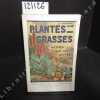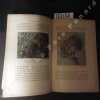-
Type
Autograph (1)
Book (2868)
Drawings (1)
Magazine (55)
Photographs (2)
-
Latest
Last month (31)
Last week (11)
-
Language
English (2)
French (2923)
Italian (2)
-
Century
17th (2)
18th (37)
19th (284)
20th (1280)
21st (88)
-
Countries
Belgium (351)
Canada (7)
Côte d'Ivoire (3)
Denmark (217)
France (2004)
Italy (27)
Switzerland (318)
-
Syndicate
ALAC (7)
CLAM (1)
CLAQ (1)
ILAB (839)
NVVA (141)
SLACES (141)
SLAM (423)
Les plantes grasses autres que les cactées
1935 A Paris, Librairie Agricole et Horticole de la Maison Rustique - 1935 - In-12, broché, couverture illustrée - 178 p. - Ouvrage orné de 83 photographies in texte en N&B
Bon état - Menus frottements sur la couverture
La vie et ses formes.
Couverture rigide. Cartonné. 201 pages. Légères rousseurs.
Livre. Préface de Adolf Portmann. Editions Bordas, 1968.
Géochimie : Géodynamique et cycles
Dunod 2009 416 pages 17x24x2cm. 2009. Broché. 416 pages.
Comme neuf
Dominica’s Birds.,
Dominica, Forestry, Wildlife & Parks Divison 2005, in-8vo, 135 p. orig. illustr. hardbacks.
JAMES, A. (a. o.): Dominica’s Birds. Dominica, Forestry, Wildlife & Parks Divison, 2005, 135 p./ 3) SAYRE, J.& A.: The Sun Catchers Hummingbirds. Minnesota, North Worth, 1999, 143 p./ 4) SOPER, M.: New Zealand Birds. Christchurch, Whitcoulls Publishers, 1976, 251 p., ex libris from the former owner (1981) on the half-title./ 5) FONTAINE, P. (e. a.): Manu. Les oiseaux de Polynésie. Pirae, Au Vent des îes, 1999, 63 p.

(SLACES, NVVA)
Phone number : 41 (0)26 3223808
The Molecular Biology of Development
Clarendon Press / Oxford 1965 in8. 1965. Cartonné jaquette.
Bon état sous rhodoïd intérieur propre avec sa jaquette
Cell Respiration
The English Universities Press Ltd. - Unibooks , Modern Biology Series Malicorne sur Sarthe, 72, Pays de la Loire, France 1971 Book condition, Etat : Bon paperback, editor's wrappers grand In-8 1 vol. - 144 pages
39 text-figures 1st paperback Contents, Chapitres : Preface, Abbreviations, Contents, vi, Text, 138 pages - The system - Hard-core respiration - Respiration without oxygen - Oxidative decarboxylation and exergonic carboxylation - Oxidation - Special oxydations - Oxygen supply - The regulation of respiration - Respiration and fine structure - Index nice reparation on few folios repasted on the spine, else near fine copy, no markings, complete
Sur la phylogénèse de l’orthobionte.
Limoges,, Ducourtieux et Gout,, Limoges,, Ducourtieux et Gout,1916 ; in-8, broché. 72pp., 6ff. de tableaux, 8ff. de planches.
Le cerveau et la pensée
Paris, Germer Baillière 1867 180pp., br.orig., 19cm., dans la série "Bibliothèque de philosophie contemporaine", peu de rousseurs, bon état, F80437
"L'instinct; études de psychologie animale d'après W. McDougall. Collection : Questions disputées."
Paris, Desclée De Brouwer, 1938. 12 x 19, 189 pp., broché, bon état (couverture légèrement défraîchie).
Hommage autographe de l'auteur.
PRÉCIS DE RADIODIAGNOSTIC. Technique et clinique
Paris Masson & Cie, Éditeurs 1913 in 8 (23x16) 1 volume reliure percaline beige ornée de l'éditeur, dos et plat supérieur titrés, XXII et 438 pages [1], avec figures et 48 planches hors texte en noir et blanc (reproductions de clichés radiographiques). 1°/ L'instrumentation (Historique; Les rayons de Röntgen; Le courant électrique; L'ampoule à rayons X; Les appareils destinés à l'excitation de l'ampoule à rayons de Röntgen; Types d'installations; Les instruments auxiliaires; Les moyens de protection). 2°/ Technique du radiodiagnostic; Application à l'homme normal (Technique générale; Technique spéciale). 3°/ Le radiodiagnostic en clinique (Généralités; Recherche des corps étrangers; Lésions du squelette; Affections des organes internes). Dr. Jaugeas, Assistant de Raditothérapie à l'Hôpital Saint-Antoine, Chef du Laboratoire de Radiologie du Dr. Béclère. Première édition. Bon exemplaire ( Photographies sur demande / We can send pictures of this book on simple request )
Bon Reliure
Les éléments chimiques et le monde vivant
Flammarion 1952 in12. 1952. Broché. Les éléments chimiques et le monde vivant (groupement des notions sur les éléments chimiques cités - composition élémentaire des organismes : éléments majeurs éléments mineurs (oligo-éléments) - éléments biogènes : recherches sur les végétaux inférieurs - recherches sur les végétaux supérieurs ...)
dos recollé couverture déraîchie bords frottés livre jauni présencec d'annotations au stylo bleu
Perspectives nouvelles dans la chimie des êtres vivants - L'évolution de la notion de vitamine , n° 1073 de cette collection
Hermann et Cie , Actualités Scientifiques et Industrielles Malicorne sur Sarthe, 72, Pays de la Loire, France 1949 Book condition, Etat : Bon "broché, sans la couverture habituelle gris foncé des ""Actualités""" Grand In-8 1 vol. - 29 pages
Après Darwin (l'arbre biologique).
Paris Baillière 1933 Un volume in-8 broché, 332 pages, un tableau dépliant. Mouillure aux deux plats, envoi de l'auteur.
La librairie est ouverte du mardi au samedi de 9h30 à 12h30 et de 13h30 à 19h00. Commandes par courriel ou téléphone. Envoi rapide, emballage soigné.
Pourquoi la mort ? - l'intériorisation (avant-propos d'Alfred Mortier)
, Paris, J.Oliven 1926, 245pp., 2e éd., dans la série "Philosophie vérifiable - le plan biologique", pour la plupart non coupé, couv. peu usagée, F23794
La vie est belle - Les surprises de l'évolution
Paris, Seuil 1991 396pp.avec ills., br., bel état
Comme les huit doigts de la main - Réflexions sur l' histoire naturelle
PARIS, Ed. du Seuil - 1996 - In-8 - Broché - Couverture illustrée en couleurs - Traduit de l'américain par Michel Blanc - Illustrations NB dans le texte - Bibliographie, index - 507 pages
- Livraison a domicile (La Poste) ou sur simple demande en Mondial Relay.- ATTENTION: Colis recommandé uniquement sur demande (parcel recommended on request). Si vous désirez un remboursement équivalent au montant de votre achat, en cas de perte détérioration ou spoliation, demandez-nous expressément un envoi en recommandé ( if you wish a repayment equivalent to the amount of your purchase, in case of loss - deterioration or despoliation, ask us expressly for a sending recommended)- Conditions de vente : Les frais de port sont affichés à titre Indicatifs (pour un livre) Nous pouvons être amené à vous contacter pour vous signaler le surcoût du au nopmbre de livres achetés ou du poids de ceux-ci. - Conditions of sale : The shipping costs are displayed as an indication (for one book) We may need to contact you to inform you of the cost of the additional shipping depending on the weight and the number of books- Possibilité d'envoi par Mondial-Relay - Réception en boutique sur rendez-vous. Librairie G. PORCHEROT - SP.Rance - 0681233148
The structure and properties of biomolecules and biological systems / Advances in chemical physics VOLUME VII
Interscience publishers 1964 in8. 1964. Cartonné.
Bon état couverture un peu défraîcie étiquette sur le dos intérieur propre
Traité de Culture Potagère (Petite et Grande Culture)
Paris, G. Masson Editeur, 1895. Cartonné et toilé, 12 cm x 18 cm, 491 pages, 114 figures in-texte. Texte de J. Dybowski. Quelques annotations manuscrites au crayon à papier sinon bon état
Traité de zootechnie générale. Tome 1 seul : Génétique générale.
Couverture rigide. Broché. 175 pages.
Livre. Avec 121 figures dont XXI hors-texte. Editions Vigot frères, 1945.
Les oiseaux dans leurs milieu
Lausanne, editions rencontres, collection "La grande encyclopedie de la nature", volume n.14, 1971. Format 17x27 cm, reliure toilee sous jaquette illustree, 383 pages. Tres bon etat.
PERSONNALITE BIOLOGIQUE de l'HOMME
Un ouvrage de 268 pages, format 125 x 185 mm, illustré de 60 figures dans le texte, relié cartonnage dos cuir à cinq nerfs, publié en 1921, Ernest Flammarion Editeur, collection "Bibliothèque de Philosophie Scientifique", bon état
Phone number : 04 74 33 45 19
ANATOMIE COMPAREE DES VERTEBRES + Livret de planches
1958 / 206 pages + 68 planches comprenant 523 figures couleurs. Editions du griffon neuchatel
Très bon état pour le livre et le livret de planches.
Le rayonnement infrarouge
1948 - 1949 Gauthier-Villars éditeurs collection des actualités radiobiologiques broché. Bon état, petits accrocs sur la couverture.
Complet en 2 tomes, 764p en pagination continue. Table : applications biologiques, physiques et techniques : utilisations de l'infrarouge ne demandant pas de décomposition spectrale (applications industrielle, médicales, biologiques, photographie infrarouge) - utilisation demandant une décomposition spectrale (récepteurs non sélectifs et technique expérimentale, récepteurs sélectifs, sources, astrophysique, analyse chimique).
Phone number : 04 76 97 79 28
Gandhi L'Insurge l'épopée de la marche du sel
Albin Michel 1997 287 pages in8. 1997. BROCHE AVEC COUVERTURE SOUPLE ILLUSTREE. 287 pages.
Très bon état
"La genèse des faunes terrestres; éléments de biogéographie. Bibliothèque de l'Institut Maritime et Coloniale."
Paris, Presses Universitaires de France, 1942. "19 x 24, 514 pp., 213 figures, 8 planches, broché, état moyen (couverture défraîchie; papier jauni)."
 Write to the booksellers
Write to the booksellers





















